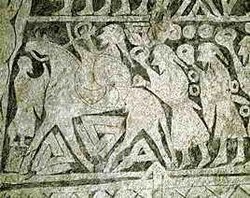Seiðr
Seid or Seiðr is an Old Norse word for a kind of sorcery which was practised in Norse society. It is connected with Norse religion. No one knows where seid came from. It was practiced less with the spread of Christianity in Scandinavia. The practice was recorded in Norse stories (sagas) found by archeologists. Many scholars say that seid was like shamanism.
Both male and female Scandinavians practiced this form of magic. By doing so, they were often persecuted by society because they brought a taboo on themselves.
In pre-Christian Norse mythology, seid was associated with the god Odin, their god of war, poetry and sorcery. It was also associated with the goddess Freyja, who was their goddess of love and fertility.
Today, followers of modern paganism adopted forms of magic that they called seid. Their practices have since been studied by many researchers in the field of pagan studies.
More reading
- Price, Neil (2002). The Viking Way: Religion and War in Late Iron Age Scandinavia. Uppsala: Department of Archaeology and Ancient History, Uppsala University. ISBN 91-506-1626-9.
- Blain, Jenny (2002). Nine Worlds of Seid-Magic: Ecstasy and Neo-Shamanism in North European Paganism. London: Routledge. ISBN 0-415-25650-X.[dead link]
- DuBois, Thomas A. (1999). Nordic Religions in the Viking Age. Philadelphia: University of Pennsylvania Press. ISBN 0-8122-3511-8. Ch. 6.
Seiðr Media
The Skern Runestone has a curse regarding a 'siþi' or 'seiðr worker'.
The 7th century Tängelgårda stone shows Óðinn leading a troop of warriors all bearing rings. Valknut symbols are drawn beneath his horse, which is depicted with four legs.
Freja (1905) by John Bauer (1882–1918)


